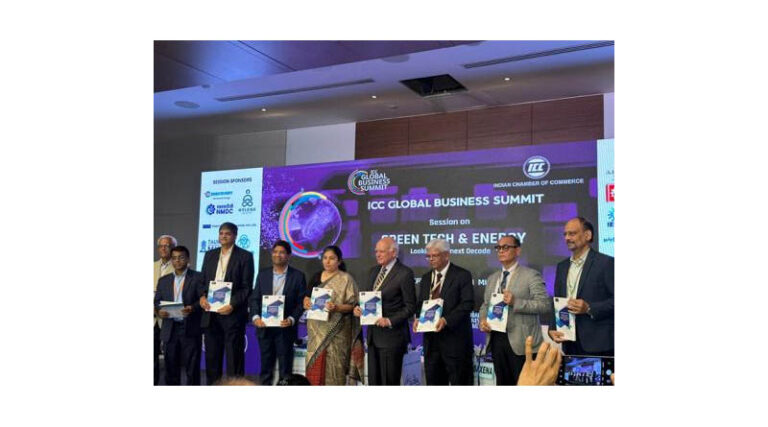
TERI Highlights Workforce Imperatives for India’s Clean Energy Ambitions at ICC Global Business Summit 2025
22 September 2025, New Delhi: TERI releases a knowledge paper “Emerging Energy Technologies and Workforce Transformation in India”
As the knowledge partner for the ICC Global Business Summit 2025, The Energy and Resources Institute (TERI) contributed to the Green Tech & Energy Forum, emphasizing the critical link between India’s clean energy goals and its workforce.
The forum’s opening address by Mr Anil Razdan, former Secretary at the Ministry of Power, underscored the urgent need to mitigate global warming. He highlighted that this is the era of chemical engineers and innovators who must solve complex challenges and stressed the need for global collaboration to train both current and future generations in emerging technologies.
Mr AK Saxena, Senior Director at TERI, reinforced this message by pointing to the “twin drivers” of demand-pull and knowledge-push in technology development. He stressed the importance of aligning India’s human capital with its clean energy ambitions.
In this context, TERI has released a knowledge paper, “Emerging Energy Technologies and Workforce Transformation in India.” The paper outlines key technology trends, market trajectories, and skill gaps, proposing a strategic roadmap to align the nation’s workforce with its clean energy future.
Context
India’s transition to a clean, resilient economy by 2047 depends not just on technology but on a skilled workforce. Rapid advancements in sectors like green hydrogen, semiconductors, and AI are facing a significant constraint: a talent shortage that could slow down progress.
Technology and Market Landscape
- Green Hydrogen: India targets 5 MMT per annum by 2030, backed by ₹19,744 crore under the National Green Hydrogen Mission. Electrolyser manufacturing is scaling, with tenders breaking the ₹50/kg green ammonia barrier. The challenge is cost competitiveness and creating skilled talent for stack engineering, hydrogen safety, and compression-logistics.
- Waste-to-Energy: Installed capacity has nearly doubled since 2020, but at ~855 MW remains only 15 per cent of potential. Projects are challenged by poor waste segregation, public acceptance, and shortage of plant-ready operators. Policy reforms, PPPs, and better training can unlock urban waste’s 5,690 MW energy potential.
- Semiconductors: The $10 billion India Semiconductor Mission has attracted multiple fab and ATMP proposals. Micron’s $2.75 billion facility is a milestone, but fewer than 200 professionals in India have fab experience, making workforce development urgent.
- AI & Data Centres: Data centre capacity is projected to grow 6–7× by 2030, with $14 billion in committed investment. AI adoption can cut renewable forecasting errors by 20–30 per cent, but a shortage of grid-AI engineers, MLOps specialists, and critical-environment technicians is a significant risk.
Skill Gap and Workforce Imperatives
Current workforce readiness is inadequate: over 65 % of new clean-energy roles require re-skilling, yet formal vocational training reaches only 4 % of India’s labour force. Semiconductor fabs, hydrogen hubs, and AI-driven grid projects face project delays if talent gaps persist. Key roles identified include electrolyser stack engineers, CBG process operators, cleanroom technicians, and grid-AI engineers. Demand for many of these roles is projected to more than double by 2030, underscoring the need for immediate action on curricula, apprenticeships, and certification pathways.
Strategic Roadmap
The report recommends integrating human capital development into every mission and incentive programme. The roadmap proposes:
- Integrated Planning: Workforce annexes specifying role counts and training targets for every major project.
- Certification First: Nationally recognised, vendor-validated credentials to make skills portable and trusted.
- Practice-Focused Training: Labs, simulators, and plant residencies to shorten time from training to deployment.
- Demand Aggregation: Industry clusters to publish 3–5-year hiring forecasts to guide academic capacity planning.
Enablers and Outcomes
Four system-level enablers are critical:
- Workforce mandates embedded in tenders
- Outcome-linked funding tied to placement rates
- A national skills dashboard for real-time visibility
- Faculty and trainer development through industry sabbaticals
If implemented, this strategy could deliver higher placement rates, higher productivity across assets, and an exportable pool of skilled professionals, turning India’s demographic dividend into a competitive advantage in the global clean energy economy.
Also Read: SML Limited Nematicide Receives Provisionally Approved ISO Common Name “Fenargimine”
📢 If You’re in Agriculture, Make Sure the Right People Hear Your Story.
From product launches to strategic announcements, Global Agriculture offers unmatched visibility across international agri-business markets. Connect with us at pr@global-agriculture.com to explore editorial and advertising opportunities that reach the right audience, worldwide.






